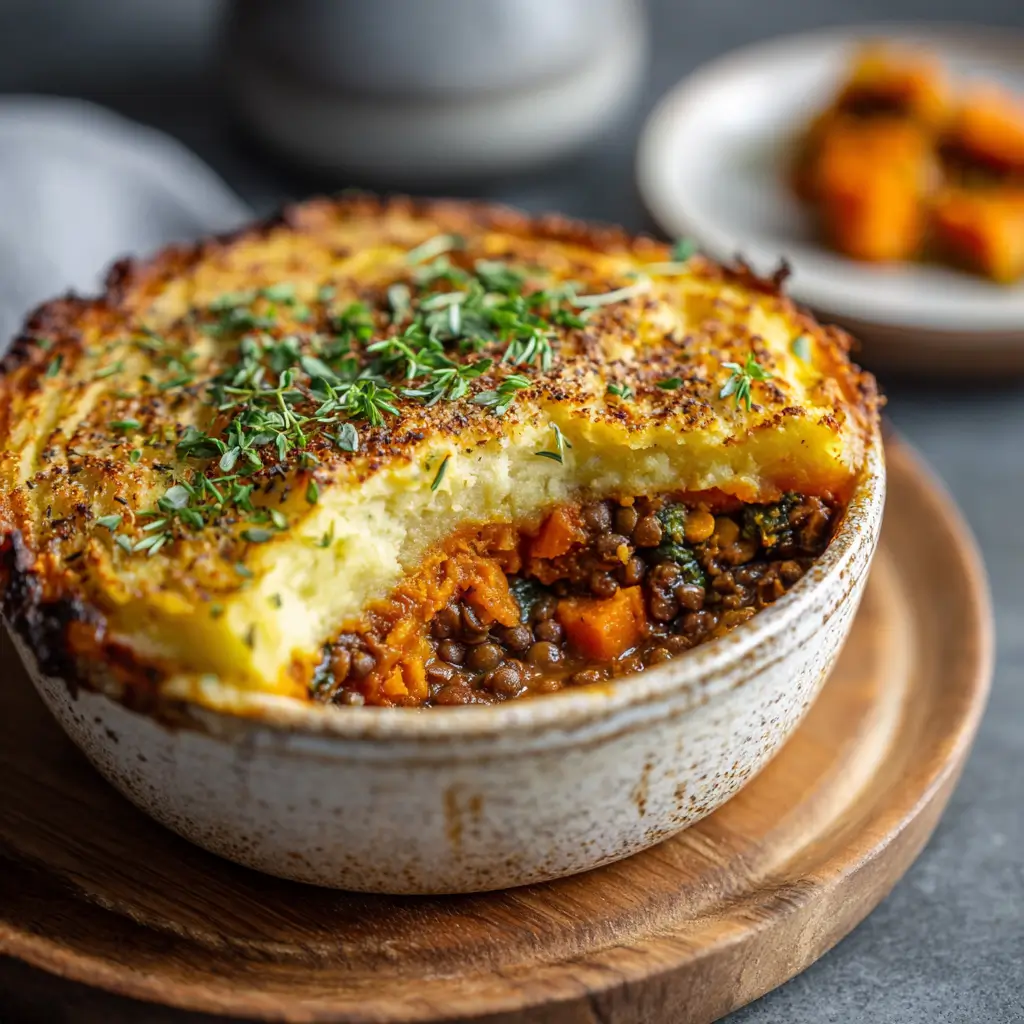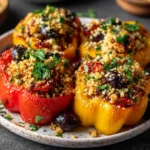Lentil and Sweet Potato Shepherd’s Pie: A Hearty, Wholesome Plant-Based Comfort Classic
The Lentil and Sweet Potato Shepherd’s Pie is a modern, plant-powered twist on a beloved British classic. Traditionally made with ground lamb or beef, shepherd’s pie has long been cherished for its rich, savory filling and creamy mashed potato topping baked to golden perfection. This vegan version reimagines the dish using protein-rich lentils and vibrant sweet potatoes, offering a nutritious, fiber-packed alternative that doesn’t compromise on flavor or comfort. Whether you’re a committed vegan, vegetarian, or simply looking to incorporate more plant-based meals into your diet, this recipe delivers warmth, satisfaction, and a beautiful balance of earthy, sweet, and umami notes in every bite.
The History of Shepherd’s Pie
Shepherd’s pie originated in the United Kingdom during the late 18th or early 19th century as a practical way to use up leftover roasted meat, particularly lamb. The term “shepherd” refers to someone who tends sheep, hence the name when lamb is used; if beef is used instead, the dish is traditionally called “cottage pie.” Originally, it was a humble meal for working-class families—affordable, filling, and made from readily available ingredients.
Cooked meat would be combined with vegetables and gravy, then topped with mashed potatoes and baked until bubbly and golden. Over time, the dish evolved into a standalone recipe rather than just a way to repurpose leftovers. Its popularity spread across the British Commonwealth and eventually around the world, adapting to local tastes and dietary preferences.
Today, with the rise of plant-based eating and increased awareness of sustainability and health, many are turning to meatless versions of traditional dishes. Lentil and Sweet Potato Shepherd’s Pie is a perfect example of this evolution—honoring tradition while embracing inclusivity, nutrition, and environmental consciousness. By replacing animal protein with hearty lentils and swapping white potatoes for nutrient-dense sweet potatoes, this version not only aligns with modern dietary trends but also enhances the dish’s natural sweetness and depth of flavor.
Ingredients Breakdown: What Makes This Dish So Special?
This recipe is built on layers of wholesome, real-food ingredients that each contribute unique textures, flavors, and nutritional benefits. Let’s explore them one by one:
- Brown or Green Lentils: These legumes are the star of the filling, providing a meaty texture and an excellent source of plant-based protein and fiber. They hold their shape well after cooking, giving the pie a satisfying bite without turning mushy.
- Sweet Potatoes: Rich in beta-carotene (which converts to vitamin A), antioxidants, and complex carbohydrates, sweet potatoes lend a natural sweetness and velvety creaminess to the topping. Their vibrant orange hue adds visual appeal and boosts immune support.
- Olive Oil: Used for sautéing, olive oil provides heart-healthy monounsaturated fats and helps build flavor by caramelizing onions and garlic.
- Onion, Garlic, Carrots, and Celery: The aromatic base known as mirepoix forms the flavor foundation of the filling. When cooked slowly, these vegetables release natural sugars and deepen the overall savoriness.
- Mushrooms (optional): Adding mushrooms introduces a deep umami flavor and a meaty chew, enhancing the richness of the dish. Cremini or button mushrooms work beautifully here.
- Tomato Paste: Concentrated and rich, tomato paste adds acidity, color, and a subtle tang that balances the sweetness of the potatoes.
- Vegetable Broth: Acts as the liquid base for the filling, infusing moisture and savory depth. Choose low-sodium if possible to control salt levels.
- Worcestershire Sauce (vegan version): A secret weapon for umami! Traditional Worcestershire contains anchovies, so be sure to use a certified vegan brand to keep this dish plant-based.
- Soy Sauce or Tamari: Enhances savoriness and adds depth through fermented complexity. Tamari is gluten-free and often smoother in flavor.
- Dried Herbs (thyme, rosemary, sage): Earthy herbs bring warmth and rustic charm, evoking the cozy essence of home-cooked meals.
- Frozen Peas: Added at the end, peas introduce pops of freshness, sweetness, and bright green color, along with extra fiber and vitamins.
- Unsweetened Plant Milk (such as almond, oat, or soy): Used to mash the sweet potatoes, plant milk adds creaminess without dairy. It blends seamlessly and keeps the topping smooth and fluffy.
- Lemon Juice (optional): A small splash can brighten the sweet potato mash and prevent oxidation, keeping the color vibrant.
- Nutmeg (a pinch): Complements the sweetness of the potatoes and adds a warm, slightly spicy note that elevates the entire dish.
Step-by-Step Recipe: How to Make Lentil and Sweet Potato Shepherd’s Pie
Ingredients
For the Filling:
- 1 cup dried brown or green lentils (or 2.5 cups cooked)
- 2.5 cups water (if cooking lentils)
- 2 tablespoons olive oil
- 1 large yellow onion, diced
- 3 cloves garlic, minced
- 2 medium carrots, diced
- 2 celery stalks, diced
- 8 oz mushrooms, chopped (optional)
- 2 tablespoons tomato paste
- 2.5 cups low-sodium vegetable broth
- 1 tablespoon vegan Worcestershire sauce
- 1 tablespoon soy sauce or tamari
- 1 teaspoon dried thyme
- 1 teaspoon dried rosemary (crushed)
- ½ teaspoon dried sage
- 1 cup frozen peas
- Salt and black pepper to taste
For the Sweet Potato Topping:
- 2.5 lbs (about 3–4 medium) sweet potatoes, peeled and cubed
- ¼ cup unsweetened plant-based milk (oat, almond, or soy)
- 2 tablespoons olive oil or vegan butter
- ½ teaspoon sea salt (or to taste)
- ¼ teaspoon freshly ground black pepper
- ⅛ teaspoon ground nutmeg
- 1 tablespoon lemon juice (optional)
Directions
- Cook the Lentils: Rinse the lentils under cold water. In a medium saucepan, combine lentils and 2.5 cups water. Bring to a boil, then reduce heat to low, cover, and simmer for 20–25 minutes until tender but not mushy. Drain any excess water and set aside. (Alternatively, use pre-cooked lentils.)
- Preheat Oven: Preheat your oven to 375°F (190°C). Lightly grease a 9×13-inch baking dish or a deep casserole dish with olive oil or non-stick spray.
- Prepare the Filling Base: In a large skillet or Dutch oven, heat olive oil over medium heat. Add diced onions and sauté for 5 minutes until translucent. Add carrots and celery, and cook for another 7–8 minutes, stirring occasionally, until softened.
- Add Aromatics: Stir in the garlic and mushrooms (if using), and cook for 5–6 minutes until mushrooms release their moisture and begin to brown.
- Build Flavor: Push vegetables to one side of the pan. Add tomato paste to the center and cook for 1–2 minutes, stirring constantly to caramelize slightly. This step deepens the flavor significantly.
- Combine Ingredients: Stir tomato paste into the vegetables. Add cooked lentils, vegetable broth, vegan Worcestershire sauce, soy sauce, thyme, rosemary, and sage. Mix well, bring to a gentle simmer, and cook uncovered for 15–20 minutes, allowing the mixture to thicken. Stir occasionally to prevent sticking.
- Add Peas: Stir in frozen peas and cook for 2–3 minutes until heated through. Taste and adjust seasoning with salt and pepper. Remove from heat.
- Make the Sweet Potato Mash: While the filling simmers, place sweet potato cubes in a large pot and cover with cold water. Bring to a boil and cook for 12–15 minutes until fork-tender. Drain thoroughly and return to the pot.
- Mash the Topping: Add plant milk, olive oil (or vegan butter), salt, pepper, nutmeg, and lemon juice (if using). Mash with a potato masher or hand mixer until smooth and creamy. Avoid overmixing, which can make the mash gluey.
- Assemble the Pie: Transfer the lentil filling into the prepared baking dish, spreading it evenly. Spoon the sweet potato mash over the top, starting around the edges to seal in moisture. Use a fork to create decorative ridges, which will help crisp the surface during baking.
- Bake: Place the dish in the preheated oven and bake for 25–30 minutes, or until the filling is bubbling and the topping is lightly golden. For extra browning, broil for 2–3 minutes at the end, watching closely to avoid burning.
- Cool Slightly: Allow the pie to rest for 10–15 minutes before serving. This helps the filling set and makes slicing easier.
Tips for the Perfect Lentil and Sweet Potato Shepherd’s Pie
- Don’t Overcook the Lentils: Mushy lentils ruin the texture. Cook them just until tender with a slight bite—they’ll soften further in the oven.
- Use Starchy Sweet Potatoes: Varieties like Beauregard or Garnet work best. Avoid overly watery types that can make the mash runny.
- Thicken the Filling: If your filling seems too wet before baking, mix 1 teaspoon cornstarch with 1 tablespoon cold water and stir it in. Simmer for 2–3 minutes to thicken.
- Enhance Umami: Add a splash of liquid smoke, miso paste (½ tsp), or a few chopped sun-dried tomatoes for deeper savory flavor.
- Make Ahead Friendly: Assemble the pie up to 2 days in advance and refrigerate. Add 10–15 minutes to baking time if starting cold.
- Freeze for Later: Fully assembled or baked, this pie freezes beautifully for up to 3 months. Thaw overnight in the fridge before reheating.
- Golden Topping Tip: Brush the sweet potato layer with a little melted vegan butter or sprinkle with nutritional yeast before baking for extra richness and color.
- Rest Before Serving: Cutting too soon can cause the filling to spill out. Letting it rest allows flavors to meld and structure to stabilize.
Variations and Customizations
This recipe is incredibly versatile. Here are some creative ways to personalize your Lentil and Sweet Potato Shepherd’s Pie:
- Root Vegetable Mash: Replace half the sweet potatoes with parsnips, carrots, or rutabaga for a more complex, earthy topping.
- Spicy Kick: Add a pinch of cayenne, smoked paprika, or diced jalapeño to the filling for heat.
- Herb-Infused Topping: Stir chopped fresh parsley, chives, or thyme into the sweet potato mash for brightness.
- Gluten-Free Option: Ensure all sauces (especially Worcestershire and soy sauce) are certified gluten-free. Use tamari instead of soy sauce.
- Cheesy Version: Mix ½ cup shredded vegan cheddar into the sweet potato topping or sprinkle on top before baking.
- Protein Boost: Add ½ cup crumbled tempeh or textured vegetable protein (TVP) to the filling.
- Low-Carb Alternative: Swap sweet potatoes for cauliflower mash. Steam florets and blend with olive oil, garlic, and nutritional yeast.
- Mediterranean Twist: Use red lentils, add olives, artichokes, and oregano, and top with a garlicky white bean mash.
- Curried Version: Stir 1–2 tablespoons curry powder into the filling and add raisins or apricots for sweetness.
- Kid-Friendly: Reduce herbs and spices slightly, and add a touch of maple syrup to the mash to appeal to younger palates.
Health Considerations and Nutritional Value
Lentil and Sweet Potato Shepherd’s Pie is a powerhouse of nutrients, making it an excellent choice for those seeking balanced, whole-food meals. Here’s a breakdown of its key health benefits:
- High in Fiber: Both lentils and sweet potatoes are rich in dietary fiber, promoting digestive health, stabilizing blood sugar, and supporting satiety—ideal for weight management.
- Plant-Based Protein: Lentils provide about 18g of protein per cooked cup, making this dish a solid option for vegans and vegetarians needing protein at dinner.
- Vitamin A Powerhouse: Sweet potatoes are loaded with beta-carotene, which the body converts into vitamin A—an essential nutrient for vision, immune function, and skin health.
- Rich in Antioxidants: Sweet potatoes, carrots, and tomatoes contain antioxidants like carotenoids and lycopene, which combat oxidative stress and inflammation.
- Heart-Healthy Fats: Olive oil contributes monounsaturated fats, linked to reduced risk of heart disease.
- Low in Saturated Fat: Naturally free from animal products, this dish is low in saturated fat and cholesterol-free.
- Good Source of Iron and Folate: Lentils are high in non-heme iron and folate, important for energy production and cell regeneration. Pair with vitamin C-rich foods (like bell peppers or a side salad) to enhance iron absorption.
- Diabetes-Friendly (in moderation): Despite natural sugars, the fiber and complex carbs help moderate blood glucose response. Portion control is key.
Nutritional Estimate (per serving, serves 6):
- Calories: ~320–360
- Protein: 14g
- Fat: 8g (mostly healthy fats)
- Carbohydrates: 55g
- Fiber: 15g
- Sugar: 12g (naturally occurring)
- Sodium: 450–600mg (depending on broth and sauces)
- Vitamin A: >200% DV
- Iron: ~30% DV
Frequently Asked Questions (FAQ)
Can I use canned lentils instead of dried?
Yes! Use two 15-oz cans of lentils, drained and rinsed. Skip the boiling step and add them when combining ingredients. Reduce broth by ½ cup since canned lentils add moisture.
Why did my sweet potato topping turn out watery?
This usually happens if the sweet potatoes weren’t drained well or were overcooked. Always drain thoroughly and consider simmering the mash uncovered for a few minutes to evaporate excess moisture.
Can I make this gluten-free?
Absolutely. Just ensure your vegetable broth, soy sauce (use tamari), and Worcestershire sauce are labeled gluten-free.
Is this recipe freezer-friendly?
Yes! Bake, cool completely, wrap tightly, and freeze for up to 3 months. Reheat covered in the oven at 350°F until warmed through (about 45–60 minutes).
Can I use regular potatoes instead of sweet potatoes?
Of course. Russet or Yukon Gold potatoes make a classic topping. Adjust seasonings accordingly, as sweet potatoes add natural sweetness.
How do I reheat leftovers?
Reheat individual portions in the microwave for 3–4 minutes, or warm the whole dish in the oven at 350°F for 20–25 minutes, covered with foil.
What sides go well with this pie?
Try a crisp green salad with lemon vinaigrette, steamed greens (kale or broccoli), pickled vegetables, or crusty whole-grain bread.
Can I make this oil-free?
Yes. Sauté vegetables in water or broth instead of oil, and omit oil in the mash—use extra plant milk or unsweetened applesauce for creaminess.
Summary
Lentil and Sweet Potato Shepherd’s Pie is a nourishing, flavorful, and satisfying plant-based rendition of a timeless comfort food classic. Packed with fiber, protein, and essential nutrients, it’s a wholesome meal that delights both vegans and omnivores alike.










